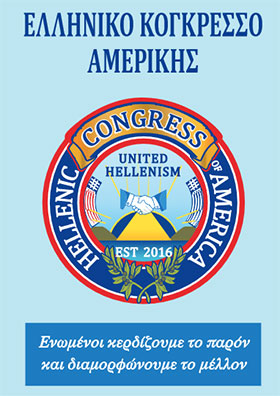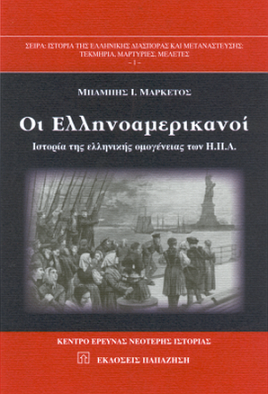Archbishop Elpidophoros supports offering of Holy Communion to everyone married in Orthodox Church – His views on priests’ appearance

The Leadership 100 29th Annual Conference, titled, “Leadership 100 Moves Forward” held at The Breakers in Palm Beach from February 20-23 Florida, centering on renewed support for the ministries of the Greek Orthodox Archdiocese in the new decade was the first Leadership 100 Conference attended by His Eminence Archbishop Elpidophoros.

At the conference, the Board of Trustees approved a grant of $5 million for St. Nicholas National Shrine, which was one of the highest priorities of the new Archbishop, and a record attendance of 525 members and their guests took in the new Archbishop’s inspirational message on his vision for the future of the Church.
Introduced the Opening Forum, Fr. Jim Kordaris, Director of Stewardship, Outreach, and Evangelism, who in a metaphor for cooperation and love likened members of the Church to trees, whose roots, intertwining beneath the earth, help nearby trees that have a need for water.
In the Forum, questions, some on controversial topics, were addressed to His Eminence Archbishop Elpidophoros. His replies, in turn, can be seen as controversial.
Archbishop Elpidophoros’s reply to the first question, whether the Church will address the issue of parishioners in interfaith marriages leaving the Church because their non-Orthodox spouses are not allowed to receive Holy Communion, was perhaps the most prominent in this category, “Thank you for this question. It gives me the opportunity to repeat to all of you what I say to my priests when they address this question to me,” said the Archbishop, “It is primarily a pastoral question how we deal with mixed marriages when one member of the family, the husband or the wife, is not Orthodox but still attends church every Sunday, is faithful to the services, and bring their children to the church. And my answer is that the communion in this family is already realized.”
For accuracy, we continue His Eminence Archbishop Elpidophoros’s complete answer to that question: “We offer to this couple the sacrament of marriage. Is marriage a sacrament or not? Is there a categorizing? Can we distinguish between Sacraments? Is there a category of Sacraments we can attend, and a category we cannot? If we are accepted in one sacrament, we cannot exclude another sacrament. That’s my principle. Marriage is a miracle that our faithful realize in daily life. How can the church give resistance to a miracle that has already happened? It’s a miracle of love; two people, who through love, are united in Christ. They already have received the sacrament of matrimony, so my direction to the priest is that we cannot exclude one Orthodox member from the Holy Communion. You know I follow always the directions and the principles that our Lord Jesus Christ Gave us: ‘Ο άνθρωπος δεν έγινε για το Σάββατο. Το Σάββατο έγινε για τον άνθρωπο.’
“We’re not here to make the life of our people more difficult,” His Eminence
continued, “We are here to bless them; to accept them to our Lord Jesus Christ and make their life easier. And blessed. That’s why we are here. If we use rules And practices that are made for different contexts, for different historical moments, then we are out of space, out of time…we are not here…we are not in the United States; we are elsewhere, and we need to realize and accept the realities that are valued here, to support our parishes, our families, and our faithful accordingly.”
Along this line of thinking, the Archbishop described the solution he offered to a Greek Orthodox parish member who asked for advice regarding the choice her son was given by his fiancée, a devout Roman Catholic, to either marry in the Orthodox Church and have their children baptized in the Roman Catholic Church, or to marry in the Roman Catholic Church and baptize their children Orthodox. “I said ‘that’s easy… let your son get married in the Roman Catholic Church. Ask your parish priest to be present with his vestments to read a prayer there. And then your parish priest can issue a marriage certificate—Orthodox.’” To audience laughter, His Eminence continued, “Why not? He was there. And there you go; you have the family getting married with the blessing of the Orthodox Church and you have the children baptized Orthodox, and you have another Orthodox family in your parish. Be practical and find solutions where people see challenges and problems. This is what I say to my priests.”
Modern priests
Saying that he likes that Archbishop Elpidophoros is “solution-based,” another person asked, “How do we attract potential priests for our communities?” His Eminence replied, “The answer is ‘by example,’ More than teaching or catechism, he said, “nothing else helps a young man to be attracted to priesthood than the ‘example’” of admirable priests, such as the “modern”, “successful” and “brilliant,” Fr. Alex (Leontis), “but if the examples we promote are irrelevant, then we have less youth attracted to the priesthood. That’s why I encourage the most intelligent, the most gifted, the most good in character youth to be a priest. Not the less good. Not the less gifted, Not second category. The best we have in our communities, because the priests are our leaders, not the Metropolitan, not the Archbishops. The priests.…so these leaders must be the best.”
Addressing George M. Cantonis, President of Holy Cross Theological School, he said, “We have a lot of work to do, George,” … to educate and prepare the priesthood of the future.’
He added that a second challenge is celibate priesthood. “Until now I did not see us encouraging celibate priesthood. And that’s a problem, because if we don’t encourage celibate priesthood, we don’t have the Bishops and Metropolitans and the Archbishops we need for our Church.”
The role of women
Commenting on a mention of “the role of women in the Church,” Elpidophoros said. “…we all know that without women, especially in the Orthodox Church, the Orthodox Church would be a failure. You can see in the church who is active…the women. Look at the men’s side and the women’s side; they are the most numerous and the most successful, and the best organized. Look at Philoptochos, it’s the best institution we have in our Archdiocese,” he said to great applause, “They have no mortgages, no debts, no financial issues. They have koulourakia, their καφεδάκι, and they collect their money and despite what we say about women, they don’t fight with each other. You know that? We fight with each other. They are peaceful. They’re doing their business. They are effective; and they are everywhere: philanthropy, Theological School, Saint Nicholas Shrine, all the ministries, Philoptochos is there.”
The title, “Archontissa”, once bestowed by the Archdiocese to women of exceptional service, but no longer given, was mentioned in another question/commentary, and addressed by the Archbishop in the positive. “I confess in public that I am trying to convince our Ecumenical Patriarch that we should start again this tradition because it’s the least we can do to recognize the role of women, in our Church, in our families, and communities,” he said.
On the Youth
Commenting on a favorable reminiscence of the Archdiocesan Young Adults League (YAL) conferences, which had purportedly been discontinued as a result of complaints that the conferences were solely recreational (comprised of “dating, dancing, swimming, etc.”), His Eminence was pleased to announce that one of the grants approved by the Board was a YAL Conference. He countered the complaints about “dating dancing swimming,” saying, “Excuse me, this is the right age to date, to dance…and at least they date and dance with each other and we keep them in Greek Orthodox family marriages.” At that age, the concern is not catechism, but “to create family and business…. That‘s not a bad thing that’s a good thing.” People to give advice on business and careers and how to be successful should be invited.
Other Issues
Regarding the Internet, after detailing historical forms of human communication, His Eminence said, in summary, that the Church has to respond to the trend and “use it for the good of the Church and of the community.”
In reply to a question about “medical assistance to suicide by our Church,” the Archbishop said, “assisted suicide is theologically unacceptable,” and that he thinks medically assisted suicide is against the Hippocratic Oath.
To a question about climate change and prayer, and “how to impact climate change by the way we treat each other,” the Archbishop replied that the term ‘climate change’ has been politicized in the United States and it’s divisive. “But we all agree that we need to protect the environment. This is what the Ecumenical Patriarch is doing since 1990,” starting from which time there is a Day of Prayer for the Environment, a special service composed by the Ecumenical Patriarchate. Translated into all possible languages, it can be found online. He feels that we our comments on climate change should be restricted, being that the topic is divisive in the United States. “I don’t want to divide people, I want to bring people together to the idea of that we have to protect the creation of our Lord Jesus Christ and respect it as a sacred creation and the violation of this protection is a sin, as our Patriarch has said.”
On monasticism
Replying to a request for information on monasticism, the Archbishop that the main task of our life is to go to paradise, to be saved, and there are many ways to do that. “There is not only one way of Orthodox piety…. We cannot say there is only one way to be saved.” Whether one chooses to be married or not, to be a member of the laity, or to be ordained, or to become a monastic, “they all are blessed…we have a rich tradition of piety and spirituality in the Orthodox Church and all are good, but we cannot say monastic spirituality is the best and it’s the only, and that the parish is very much secularized. This kind of criticism is not good, and the other way around, too: you cannot say that monastic spirituality is fanaticism, that it’s medieval, or whatever comments we can make. We have to accept each other. Some are more comfortable with monastic spirituality. Okay, let them go to a monastery and be there. Why not? Some are more comfortable with parish spirituality, which is more secular, which is more grounded to the earth. So, both are okay. I don’t claim that one is wrong and the other is right.
“Historically in the United States we face a time when monasticism is something new.” He noted that monasticism is only 30 years old here, one generation, and at the beginning there was a conflict of monastery against parish. “That’s again, normal, but now it’s time after one generation of monasticism to reconcile. Some say the monasteries are getting all the money, and they don’t support the parish. Of course, they will get some money, and they need to build the monasteries. I don’t think the big money is going to monasteries right now. The monasteries are almost built. Now they have their own places. Now we are at the historical moment of reconciliation between monastery and parish and this is what I’m trying to do and to promote, by organizing monastic governance.” Every year he will repeat what he did last September, “talk with the abbots and abbesses and make them feel not in the margins of ecclesiastical life of Church life, but that they are part of the Archdiocese. Of course, if you push someone to the margin, then he and she behave like marginalized people, and we don’t want them to be ‘there’, We want them to be ‘here.’”
On the priests appearance
For accuracy, His Eminence Archbishop Elpidophoros’s complete answer to questions about priests’ appearance is presented here. “I come from Constantinople,” said His Eminence, “In Constantinople priests do not have long beards, do not wear cassocks, do not even wear a cross. We wear suits and ties like modern people. We only have our cassock and our ρασο when we go to the church, nowhere else. Here when I came, I saw there is a new phenomenon of a new conservatism in our young clergy. The reason I asked Fr. Alexander to stand up before is to remind you what type of clergy my predecessor of Blessed Memory Archbishop Iakovos promoted. This is the type of clergy I want to bring back to our Church.
Some clergy that prefer the long beard and the more traditional appearance tell me ‘Your Eminence, we’re in a free country. Nobody bothers us if we have cassocks in public can we walk around.’ I say ‘of course you are right. This is true. Nobody will ask you why you have a beard or a cassock in public, but, you know, they will respect you, but they will never think that you belong to the American culture. They will always think you’re something exotic, respected, but you don’t belong here. They won’t insult you… this is the beauty of American culture, that’s why they love America, but the question for me is how relevant I want my clergy to be in a American Society: do I choose to be a respected exotic person, or do I want to be a relevant person to the average American. And then I want my clergy to be adopted, to be accepted by all Americans not as a something strange that I respect, but something that is relevant to me; that he is relevant. That’s what I promote. And of course, there are clergy who work their cassocks in public over 20 years now. I cannot force them to take off their ρασα. I can’t do that. I respect that they are used to this their whole lives. But the new generations, I have to come back to Archbishop Iacovo’s heritage that we had,” he said, to great applause.
Greeknewsonline.com
Photos: Dimitrios Panagos










Σχόλια Facebook